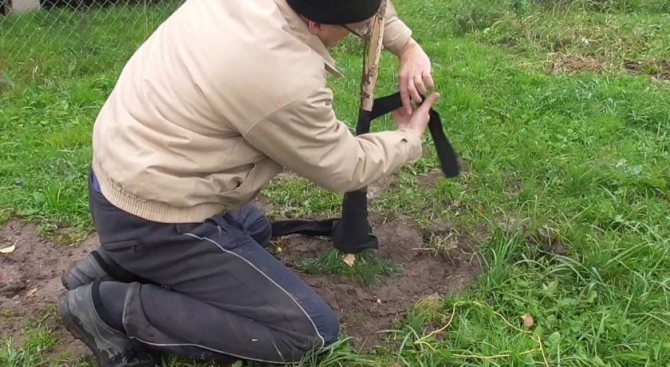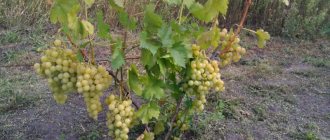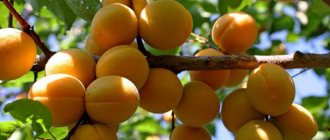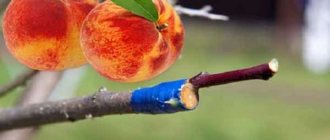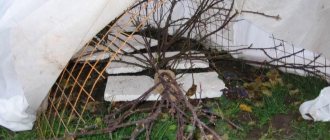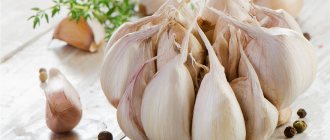Apricot care in the fall in preparation for winter
In autumn (September-October), sanitary pruning of the tree is carried out. The apricot crown is cleaned of dried branches and shaped. Please note: in order for the cut sites to heal safely, the average air temperature must be above 8 ° C.
After leaf fall, the trees are treated with 3% Bordeaux liquid. This fungicidal agent will protect plants from fungal diseases. The bole and skeletal branches are especially carefully sprayed.
In addition, to protect the tree from diseases and pests, the trunk is whitewashed with slaked lime with the addition of mullein or a special whitewash compound.
Do this in dry and cool weather.
If an unusually warm autumn comes out, fruit trees may show long shoot growth. This causes freezing of not fully ripe branches, flower buds and wood. To prevent this from happening, in August, apricots are abundantly watered with a solution of wood ash - 1 glass of the substance is diluted in 10 liters of water. About 6 buckets are spent on an adult tree.
This procedure accelerates the ripening of the shoots and stops their growth in the fall. It is also important to remove nitrogen fertilizers from the "diet" of apricot trees from the second half of summer.
Before the onset of stable cold weather, the trunk circle is mulched with peat, humus, compost or sand with the addition of sawdust. The mulch layer is about 20 cm.
Autumn feeding of apricot after fruiting
Immediately after harvesting the apricots, i.e. even in the second half of summer, it is advisable to feed apricot trees phosphorus-potassium fertilizers (in no way nitrogenous such as urea or ammonium nitrate).
If you did not do this in the summer, then of course, you can and should fertilize in the fall, for example, in September.
Most often used for this superphosphate and potassium sulfate either just potassium monophosphate (it costs more, but also more effective), or they buy ready-made special "Autumn" (= phosphorus-potassium) fertilizers for the garden. Naturally, there are organic analogue - wood ash (potassium) and bone flour (phosphorus).
Important! Usually, all fruit trees are fertilized in autumn about the same, so for example you can read See this detailed article on autumn feeding for apple trees.

By the way! All stone fruit crops are taken from the soil a lot of calcium to build your bones, so it is highly advisable to periodically feed apricots with calcium fertilizers, for example, dolomite flour (it also deacidifies the soil). Moreover, you can make them at any time - both in autumn and spring.
Video: how to feed an apricot in the fall
Top dressing on a leaf for better ripening of shoots
If at the beginning of autumn you see that a young apricot planted this spring, shoots are still quite green, i.e. unripe and non-lignified (and such shoots simply cannot overwinter and will necessarily freeze out), then to accelerate their ripening (in winter they should go brown) you need to make sure foliar top dressing (spray with a solution on the sheet) with phosphorus-potassium fertilizer (optimally - potassium monophosphate).
By the way! For the ripening of apricot shoots, it is also used summer chasing or pruning... So, the length of a young growth should not exceed 40-60 cm, everything else needs to be cut off.
How to insulate an apricot for the winter
In the snowless and frosty winter, alternating with thaws, the root collar of the apricot (the place where the horses pass into the trunk) suffers greatly. From constant temperature changes, it podoprevat. As a result, the tree's winter hardiness decreases. To prevent this, the root collar and the trunk of the tree are tightly wrapped with burlap (preferably in several layers). For this purpose, you can use other material, but it must necessarily pass air.
In regions with unstable climates, the shelter should be warmer. An adult plant is shortened to a height of 2.5 m, pegs (4-6 pieces) are driven into the ground around it, up to the first lower branches, or a wire or wooden frame is installed. From above and to the very level of the soil, the crown of the tree is wrapped with dense agrofibre (spunbond, lutrasil, agrospan, etc.) or other breathable material, attaching it to the pegs or to the frame from below. So that the shelter is not blown away by the wind, the covering material is sprinkled with earth along the entire perimeter.
A cap that protects the apricot from prickly wind and frost can also be made from roofing material, which is laid over a wooden frame.
When growing this fruit crop in regions with severe or insufficiently snowy winters, it is recommended to give preference to planting the most frost-resistant zoned apricot varieties. Because even a good shelter may not save heat-loving trees.
We hope you have no doubts about whether to cover the apricot for the winter. Insulate the tree annually in this way - and it will tirelessly bear fruit.
Features of apricot care in autumn and preparation for winter
Pre-winter care for seedlings is carried out in order to prepare for the upcoming frost. In addition to trimming the foliage, it is necessary to ensure the safety of the bark and wood. Comprehensive and proper care makes it possible to create optimal conditions for wintering plants.
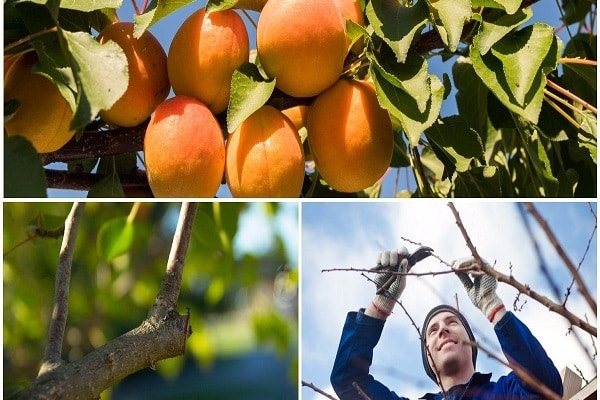

In the course of preparing the apricot for winter, the soil around the seedlings is covered with a layer of mulch made of hay, sawdust, humus and straw. Mulching is necessary to protect the roots and improve the properties of the seedlings. The root neck of the trunk is protected with a material with sufficient breathability to prevent rotting.
Heating the lower part of the trunk leads to poor tolerance to cold weather and a drop in yield.
To protect the main part of the trunk, it is necessary to treat the bark with a solution of lime. Covering will reduce the risk of pests entering under the bark and strengthen the base of the branches. Asking the question of how to prepare a protective solution, it is enough to mix 10 liters of pure water, 2 kg of lime, 200 g of copper sulphate and 250 g of flour paste.


Pruning apricot in autumn
One of the essential stages of caring for fruit trees is crown pruning.... When pruning vegetation, it is necessary to take into account a number of nuances, since the correct implementation of the process contributes to the ripening of a good harvest.
What is pruning for?
Pruning foliage and old branches is necessary to create a decorative and neat crown. Also, pruning has a practical purpose - it increases the degree of penetration of sunlight to apricots and has a beneficial effect on airing.
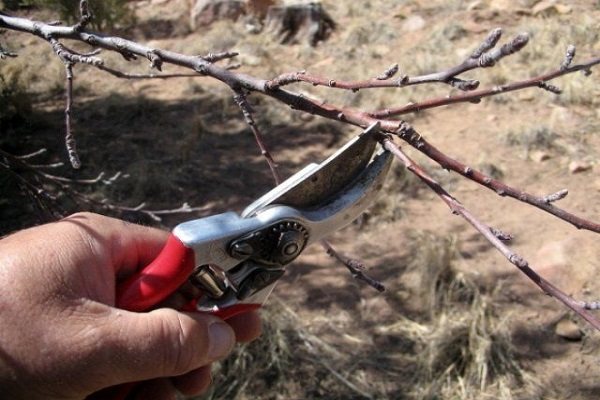

When is the best time to prune - in spring or autumn?
Pruning is allowed twice a year. In autumn, the crown of the trees is shaped and old branches are removed. In early March, with the onset of heat, the frozen shoots are removed after the cold weather. When planting in northern regions, both pruning should be done during the spring to allow the tree to fully recover during the warm season.
Pruning time
It is not necessary to delay the processing of the crown for a long period, since the cut sites should be restored until the temperature drops below 8 degrees. The exact dates are determined taking into account the weather conditions in a particular area. In the central regions, the procedure is performed during the first decade of October, in the southern area - from mid-October to November 10, in the north - at the beginning of September.
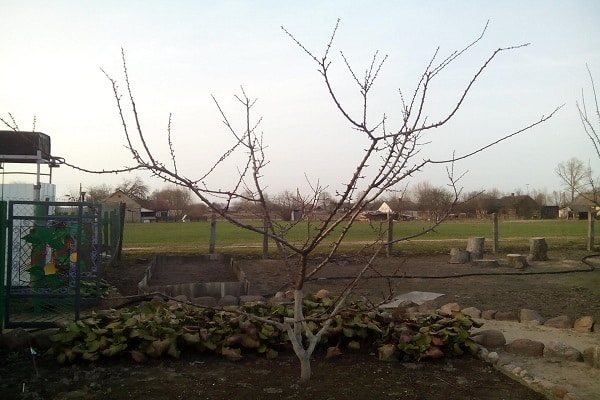

How to prune properly
To trim the crown, it is enough to follow the step-by-step instructions. It involves the following steps:
- After the first year of cultivation, the upper part of the trees is partially cut off, the length of which reaches a quarter of the height of the entire trunk.
- Several shoots are left on the trunk, shortening to at least 30 cm.
- On the 3-5th year of life of apricots, the shoots are partially removed, maintaining a distance of about 50-55 cm between the remaining ones.
- Long shoots that have formed on the central part of the stem are cut in half.
Features of pruning young and old apricots in autumn
On young seedlings, during the period of active growth of the crown, skeletal branches are left, and the rest are cut off. Side shoots are partially pruned so that they are in a horizontal position.
Adult apricots, unlike recently planted trees, are only periodically domesticated. This is necessary for the intensive growth of new branches.


Growing apricot
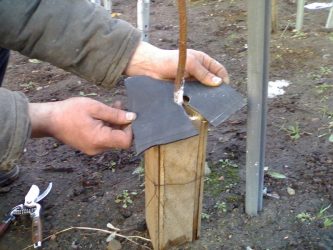

Apricot
Apricot is not in vain recognized as a tree of health, because its fruits are the main source of vitamin A among all fruit trees. It is very easy to plant and grow an apricot in your garden, because it is not picky about the soil, it can grow in ravines, ravines, on slopes. In addition, the tree is drought-resistant and loves light very much. If we compare the apricot with other fruit trees, then it begins to bloom earlier than the rest.
You can collect the fruits every year, the ovary is formed by self-pollination. The tree has an irregular crown shape; apricot can reach a height of 15 meters.
Apricot fruits differ in shape, you can see round or oval apricots, and elongated fruits are also common. Apricot is used for drying, drying, production of compotes, preserves, marmalade and other goodies. In addition, they are valuable in apricot and pits, their oil is used in medicine.
Planting an apricot
As for the apricot planting site, it is best to choose a sufficiently aerated soil in which lime is present. It is important to remember that apricots react negatively to the north wind, so it is best to avoid these planting sites. In addition, lowlands, shaded or very wet areas are not suitable for planting, as this can cause cracking of the apricot peel.
The first crop of apricots can be harvested within 5-7 years after planting. But proper care and continuous cultivation can give the first fruits in 3-4 years. To get the best result, it is more correct to plant 3-4 seedlings on the site.
As already mentioned, apricots can grow almost anywhere. Planting a tree seedling has several nuances. So, it is worth considering that the tree is very rather big, so there is no need to plant it in close proximity to other trees. It is more correct to retreat about 5 meters from another tree and boldly plant an apricot.
The soil for planting must be specially prepared; at the bottom of the pit, crushed stone or gravel must be laid out, which will play the role of drainage. In addition, mineral fertilizers, wood ash, ammonium nitrate are also important, all these components are put into the soil mixture. After placing such a solution in a pit, they need to be sprinkled with earth. This is done in order to avoid contact of the roots with this mixture. By the way, the planting hole is best prepared in the fall.
Shelter for the winter
The need for shelter is due to the insufficient frost resistance of apricots. The covering material protects the roots and maintains the optimum temperature in the lower part of the trees.
How to cover
Depending on the weather conditions and the characteristics of the particular region, the method of covering the trees depends. In the northern regions, cover trees entirely. A film material is put on over the seedlings, the edges of which are fixed with stakes in the ground.
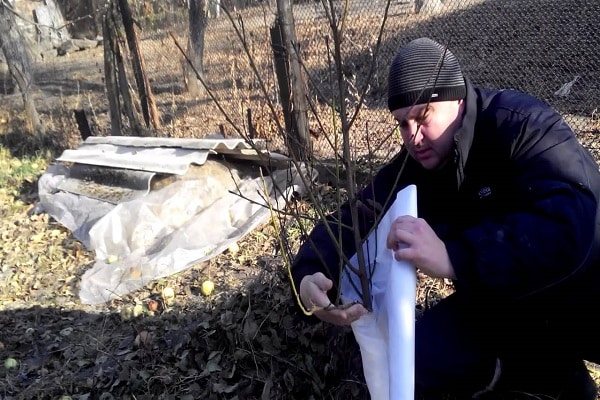

Features of the shelter of young and old apricots for the winter
Young seedlings should be protected in the first place, since their roots are at a developmental stage and can collapse during prolonged cold weather. The branches and trunk of immature apricots should be covered with burlap or a thick cloth.
Old trees planted in the middle lane need weaker insulation. The area around the roots is covered with mulch, which protects the ripening apricots from the cold. The adult apricot plantations planted in the north are protected by analogy with young ones, having previously shortened their trunks to a height of about 2.5 m.
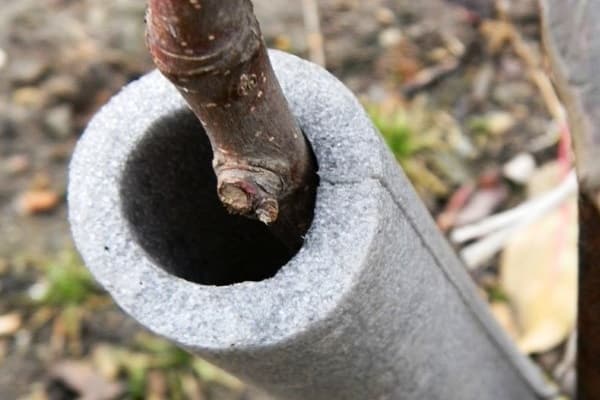

Features of preparing apricots for winter
Preparations for the winter season vary depending on the temperature characteristics of the region in which the crop is grown. The main problems that need to be prevented during the preparation process are freezing and heating.
In the middle lane
When growing fruit trees in the middle lane, it is necessary to take into account the likelihood of a sudden drop in temperature. To avoid freezing of branches and buds, mulching should be carried out in advance, wrap the trunk with covering material and ensure air permeability.
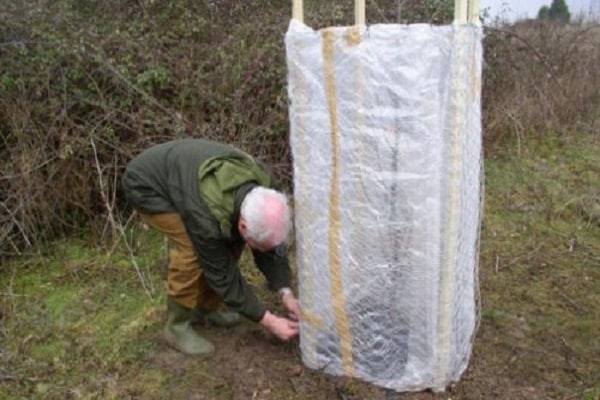

In the Volga region
To get a good harvest of apricots when grown on the territory of the Volga region, it is necessary to prune trees on the eve of winter to a height of 2.5 m.After removing old branches and excessive leaf density, mulching is required with a dense layer of coniferous branches, straw and sawdust.
For additional protection, it is recommended to cover a layer of mulch with agrospan and fix it on the soil surface.
Shelter timing and methods
Preparation of a tree for wintering begins long before the onset of cold weather, namely: after complete harvesting. In the fall, a number of crop care activities are carried out, which are aimed at its adaptation to wintering:
- Fertilization... After the entire crop is fully harvested, the plant is fed using products with a high content of phosphorus and potassium, which increase the immunity of the apricot and its frost resistance. Nitrogen-containing products must not be used, since they negatively affect the resistance to low temperatures.
- Whitewashing the trunk and branches... One of the best protective measures is the whitewashing of the plant with a solution prepared from 2.5 kg of lime, 0.4 kg of copper sulfate and 1.5 tbsp. paste made from flour. Such a mixture will protect the tree from parasites and ailments, and will also have a beneficial effect on its immunity.
- Pruning shoots... Before wintering, formative, sanitary and regulating pruning is carried out. In this case, the first is needed for the correct distribution of valuable substances inside the plant, the second is for awakening new growth points, the third is for rejuvenating the tree, removing old, rotten, dry and weak branches that interfere with the full development of the culture.
How a tree is sheltered for the winter will largely depend on the region where it grows. In warmer areas, summer residents are limited to mulching the trunk circle with a 20-centimeter layer of mulch and covering the root collar with an air-permeable canvas. As for the cold northern regions, it is better to cover the culture there completely, additionally wrapping it on top with a PVC film.
How to properly cover an apricot
Warming an apricot implies a number of activities:
- Mulching the near-trunk zone with organic materials: sawdust, hay, straw, compost, etc. Some gardeners use dry leaves as mulch, but experts do not advise doing this, since they can be an excellent environment for the development and reproduction of insect pests.
- Covering the trunk and skeletal shoots with breathable fiber.
In case of severe frosts, the trees are additionally covered with plastic wrap. However, when resorting to the use of polyethylene, it is imperative to take care of the free access of oxygen to the root system of the apricot, otherwise the roots can rot and rot.
What materials to use
Apricot, according to historical information, is a native of Armenia, which means it prefers to grow in a warm, sunny and comfortable climate. That is why, when growing a plant in climatic zones other than the south, it requires careful shelter for the winter. To protect wood from low temperatures, it is necessary to use high-quality, natural material that allows air to pass through well and does not lead to the formation of a "greenhouse effect". As a shelter, it is allowed to use:
- natural burlap;
- agrospan, agrofiber and other industrial breathable materials;
- straw or hay;
- humus or compost;
- sawdust or spruce branches.
Shelter technology for young and old apricots
It is especially important to pay attention to the preparation for the winter of a fragile young apricot, which has an incompletely developed root system that can freeze during prolonged cold weather. The trunk and skeletal branches of the plant are highly susceptible to frostbite, therefore experts recommend that young apricot seedlings be completely insulated.
The trunk and shoots should be wrapped with natural breathable material, for example, burlap or special insulation. The trunk circle also needs to be covered with a layer of mulch. In winter, when the snow falls, you can make a snowdrift about 1 m high around the tree, which will additionally protect the culture from the cold.
Video: How to cover an apricot for the winter
Old trees growing in the middle lane do not need such insulation. To protect the plants, it is enough to mulch the soil of the trunk circle, which will make it possible to insulate the root system in case of a snowless winter and, if necessary, remove excess moisture from the root collar. In the northern regions, old trees are covered according to a similar scheme with young ones, but before the procedure, skeletal branches are cut to a height of 2.5-3 m.
How to properly prepare an apricot for winter. Techniques and methods for apricot freezing.
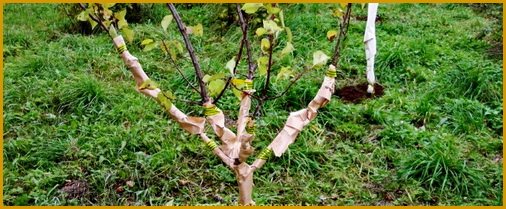

How to grow an apricot on your site, what you need to know?
It turns out that this culture needs to create special conditions. It is necessary to choose the right planting site, know all the tricks of growing apricots and do not forget about proper care.
The most destructive phenomenon for apricots is winter thaws... They provoke the onset of biochemical processes, and a sharp drop in temperature following a thaw leads to damage, first of all, of the flower buds.
Thus, partial or complete death of flower buds occurs precisely during winter, which is one of the main reasons for irregular fruiting.
Young plants are especially "afraid" of wintering in the first years of life: they are distinguished by strong and prolonged growth and do not have time to prepare themselves before the onset of frost. As a result, non-lignified shoots freeze out.
This thermophilic crop requires careful maintenance in the fall. and thorough preparation for wintering. In the climate of the middle zone, one cannot do without a warm shelter for the apricot for the winter. And you need to prepare the plant for the onset of cold weather in advance.
Features of insulation in different regions
The preparation of apricots for the winter will be largely determined by the weather conditions in the region. And if in the southern zones this event can be ignored, then in the northern zones the lack of shelter can lead to the complete death of the plant.
In outskirts of Moscow
The climate of the Moscow region is characterized by instability, short wet summers and long, cold winters. To prevent a sudden drop in temperature indicators from freezing the buds and shoots, the tree should be insulated several weeks before the expected frost. For the shelter of the culture, a natural material is used that is capable of excellent air permeability. They are wrapped around the trunk of the plant and its skeletal branches. In strong winds, the culture is additionally covered with plastic wrap.
It is mandatory to mulch the soil using straw, hay or sawdust
In the Volga region
When cultivating apricots in the Volga region, the preparation of a plant for wintering is carried out according to a different method. First of all, in autumn, branches are pruned to a length of 2.5–3 m. Further, the soil of the near-trunk circle is covered with a layer of mulch, which is perfect for spruce branches, straw or sawdust.
The tree trunk is covered with a special insulating material - agrospan, which is fixed to wooden pegs, and then sprinkled with a small layer of soil.
In the Urals and Siberia
In the cold regions of the Urals and Siberia, the preparation of the plant for wintering is carried out in a similar way, however, they additionally take care of the removal of melt water from under the root processes of the tree. The fact is that in the spring, when the snow begins to melt, water is actively absorbed into the soil, thereby provoking rotting of the root system and, as a result, its subsequent rotting. To avoid such situations, experienced gardeners make special paths required for natural drainage of water.
What will happen if you do not cover the apricot for the winter
As noted above, a shelter for the winter is one of the most important procedures for caring for an apricot, which not only protects the plant from the harmful effects of low temperatures, but also contributes to better crop yields in the next season.
If you ignore such an event, you can face a number of serious problems, some of which may be fatal for the tree.
Frostbite for apricot can cause:
- a significant decrease in plant immunity;
- complete lack of harvest or low yield indicators;
- susceptibility of culture to various kinds of diseases and pests;
- complete destruction of the tree.
Apricot is a thermophilic crop that needs high-quality shelter for the winter for good fruiting. To prepare the plant for wintering, it should be provided with proper care in the fall, which includes timely fertilization, pruning of shoots and whitewashing of the trunk. Despite a wide range of preparatory work, the efforts of gardeners in the next season will be rewarded with a decent harvest of tasty, healthy and extremely aromatic fruits.
Shelter for apricots for the winter: protecting young trees from rodents, sunburn
The last stage of caring for apricot in autumn is its direct preparation for wintering.
Of course, an adult apricot tree is quite a relatively frost-resistant crop that does not require any shelter for the winter. However, a young apricot seedling (e.g. planted this spring) still needs some protection, and first of all not from frost, but from rodents and hares, as well as from sunburn (which was described in detail in the paragraph on autumn whitewashing).
So, in order to protect young apricot from hares and rodents (mice) that like to gnaw the bark, you need wrap (more precisely, bandage) the lower part of the trunk from the ground itself to the skeletal branches special protective non-woven (= breathable) material, for example, the same spunbond or lutrasil, some kind of burlap (but by no means a film, otherwise your tree underneath it will shake out).
By the way! In this case, you even no need to whitewash the treesince white non-woven fabric and will perform a protective function to prevent sunburn (i.e., it will act as a reflector of sun rays).
Or you can buy finished tape for wrapping trunks of fruit trees for the winter.


And some gardeners even put metal frame made of mesh.
Similar wooden structures are being erected.
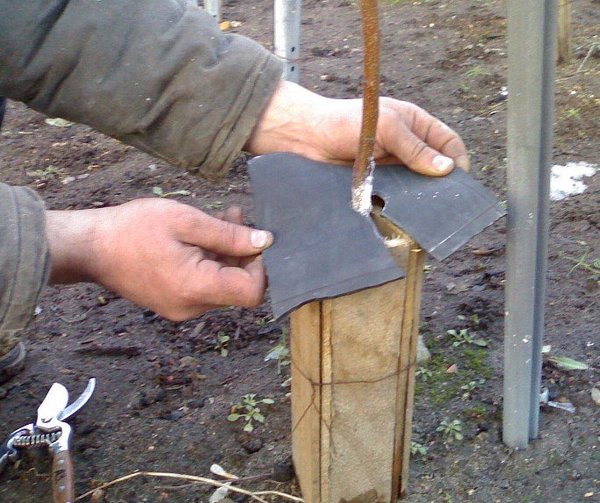

Advice! If rodents or hares have seriously damaged the bark of your apricot tree, so to speak, gnawed with a ring, then in order to save the tree, you will need it to plant in the spring with a bridge, which is described in detail in this article.
Another significant problem when growing apricots in a "raw" climate is damping of their root collar, therefore, in the fall, they must be freed from excess mulch and, if desired, additionally cover the lower part with mastic varnish to protect it from excess moisture.
Video: protecting the apricot from damping out the root collar
Well, now you know that the harvest of the next year will fully depend on the quality autumn care of the apricot tree and its proper preparation for winter. Therefore, despite the large number of autumn worries, the efforts made will undoubtedly be generously rewarded!
Video: how to properly prepare fruit trees for winter
Apricot is one of the most popular fruit trees cultivated by domestic gardeners. The culture is unpretentious in care, easy to grow, does not require special growing conditions. However, in order to get a decent harvest of tasty and aromatic apricots, before wintering the tree, you should take care of its correct and timely insulation.
General rules for autumn care
With the arrival of autumn, the preparation of the garden for winter begins. First of all, the plants are examined for the presence of harmful insects and signs of fungal and bacterial infections. Trees and shrubs are treated with insecticides and fungicides. The trunk and skeletal branches of the apricot are covered with lime whitewash. Lime saves the plant from invasions of harmful insects and small rodents, which feed on the bark of fruit crops in winter. At the next stage, water-charging irrigation is carried out, which allows the soil to be moistened to a depth of 80–100 cm.


The introduction of potassium-phosphorus fertilizers contributes to the enrichment of the soil with various nutrients and useful substances. Do not forget about mulching the soil in the trunk circle. The mulch layer protects the fruit crop from temperature extremes, cold and glaciation, and also allows the root to absorb moisture and "breathe".
Autumn is considered the ideal time for sanitary crown pruning. All old and damaged branches are removed with the help of a garden pruner. Young shoots are shortened so that the plant can be covered for the winter. But on each branch there should be several buds.
Video "Technology for sheltering apricots for the winter"
From this video you will learn how the apricot tree is prepared for the upcoming cold weather.
How to insulate an apricot
Many novice gardeners believe that there is a standard plant insulation scheme. However, this assumption is incorrect. The shelter technology depends on the varietal characteristics and age of the cultivated crop, as well as on the climatic characteristics of the growing region. Yield indicators for the next year depend on the preparation of fruit and vegetable crops for wintering.


What materials to use
As a mulch, you can use dry opal foliage, sawdust, coniferous branches, shredded cardboard, straw and trimmings of covering material.Lutrasil, agrofibre, polypropylene bags, burlap, thick cardboard, canvas and various non-woven materials are used to insulate a fruit tree. In severe frosts, the protective shelter is covered with dry earth or covered with spruce branches.
Tree shelter technology
The algorithm for sheltering an apricot tree for the winter is as follows:
- Mulching the soil in the near-trunk circle with a layer of sawdust, fallen leaves and thin branches.
- Wrapping the trunk and skeletal branches of a fruit crop with burlap or dense non-woven fabric. Fixing the material with twine.
- Warming of apricot with covering material.
- Installation of additional protection in the form of a wooden box or slate sheets during prolonged snowfalls and severe frosts.
What other stages of preparation for winter does an apricot tree need?
If the trees are often sick, it is recommended to additionally sprinkle them with Bordeaux liquid, a weak solution of copper sulfate or potassium permanganate before sheltering. Also, a few days before warming, the soil is moistened to a depth of 0.8-1 m so that the earth does not finally harden.
Reference. If you whitewashed the trunk along with the branches, it will be enough only to insulate the soil around without wrapping the trunk and branches with covering material.
Features of insulation
Let's see how to cover young and old apricots growing in different climates.
For young and old trees
A newly planted seedling that has not yet had time to adapt to the new terrain and climate needs special care. In order for a young tree to cope with the upcoming cold weather and recover with the arrival of spring, you need to carefully insulate it. In severe frosts, a protective structure made of a metal or wooden frame with a polypropylene or canvas covering is put on the tree.


The protective structure must have openings for air circulation. The absence of such gaps leads to the accumulation of moisture inside, which is fraught with the appearance of fungus and mold on the tree.
It is not possible to insulate fruit trees aged 4 years and older so thoroughly. A layer of mulch in the trunk circle and a protective coating on the trunk of the tree will be enough. But this technology of apricot insulation is suitable for the Krasnodar Territory, Kuban, Crimea, Stavropol Territory and other regions of the country with warm winters.
Features of overwintering apricot trees
The most destructive for apricots, regardless of their age, is the negative impact of winter thaws, which can provoke early biochemical processes. A sharp cold snap can cause irreversible damage, up to the death of flower buds. Temperature extremes are especially dangerous for young and newly planted fruit trees. In this regard, the question arises of how to properly insulate an apricot for the winter.
It is necessary to distinguish between the concepts of "winter hardiness" and "frost resistance". The term "winter hardiness" refers to all unfavorable factors of winter - winds, frosts, changes in humidity and temperature. The winter hardiness of the Apricot species, including its northern varieties, is still insufficient.
The concept of "frost resistance" is much narrower and means resistance to cold. In an ordinary apricot, it is quite high. In the Volga region, apricot trees tolerate severe winters quite well for many years.
The deep dormancy of the apricot is rather short - until the beginning of December. Throughout the winter, the trees are in a state of forced dormancy. This means that they are already capable of flowering and growing, from this they are stopped only by negative temperatures. To start growth, you need quite a bit of heat. Even a thaw is enough for the apricot to start growing.


During the summer, fruit-bearing trees accumulate nutrients that are necessary for a successful overwintering. Apricots in the south are covered with a "fur coat" of similar chemical compounds.In the Middle Lane, summer is moderately warm, so apricots do not have time to stock up on nutrients. They hibernate in a "light coat".
It is worth noting the advantages of the early thaw. The apricot lays a large number of flower buds on annual shoots every year, regardless of the yield last year. If sometimes partial death of the buds did not occur, then the tree would quickly deplete and their life span would be reduced. This phenomenon is quite normal, it is a natural restoration of the strength of the apricot.
Apricot care in the fall in preparation for winter
In autumn (September-October), sanitary pruning of the tree is carried out. The apricot crown is cleaned of dried branches and shaped. Please note: in order for the cut sites to heal safely, the average air temperature must be above 8 ° C.
After leaf fall, trees are treated with 3% Bordeaux liquid. This fungicidal agent will protect plants from fungal diseases. The bole and skeletal branches are especially carefully sprayed.
In addition, to protect the tree from diseases and pests, the trunk is whitewashed with slaked lime with the addition of mullein or a special whitewash compound.
Do this in dry and cool weather.
If an unusually warm autumn comes out, fruit trees may show long shoot growth. This causes freezing of not fully ripe branches, flower buds and wood. To prevent this from happening, in August, apricots are abundantly watered with a solution of wood ash - 1 glass of the substance is diluted in 10 liters of water. About 6 buckets are spent on an adult tree.
This procedure accelerates the ripening of the shoots and stops their growth in the fall. It is also important to remove nitrogen fertilizers from the "diet" of apricot trees from the second half of summer.
Before the onset of stable cold weather, the trunk circle is mulched with peat, humus, compost or sand with the addition of sawdust. The mulch layer is about 20 cm.
Preparatory work
The beginning of work is the end of September or the beginning of October. The preparation of trees is carried out in several stages:
- Until the temperature at night falls below 8 ° C, preventive pruning is carried out and the crown is formed for the next season. The remaining bark is cleaned from the trunk, all dried and overgrown branches are cut off. Places of cuts are treated with garden varnish or Bordeaux liquid.
- Further, tree feeding is carried out. Most often, wood ash is used for this (a glass in a bucket of warm water). The ash solution will not only protect the plant from diseases, feed it, but also prevent the untimely growth of shoots and budding in the event of a warm autumn.
- The last stage is soil mulching. The earth around the trunk is sprinkled with a mixture of sawdust, sand and peat (humus).
At the end of summer, before preparatory work, nitrogen fertilizers should not be applied to the soil.
Initially, gardeners and summer residents need to carry out preparatory work. For this, trees should be fertilized with phosphorus and potassium. It is also recommended to use a mixture of crushed chalk and ash. The mass belongs to the category of mineral fertilizers that do not harm the plant.
Whitewashing is a step that should also not be skipped when caring for apricots. By painting the trunk with a tested solution, summer residents eliminate the risk of insect breeding on the bark. As a rule, 2 kg of lime, 1 glass of paste and 200 g of copper sulfate are taken. The substances mix and bleach tree trunks.
It is also important to properly prepare the crown of the plant. This contributes to the distribution of the flow of nutrients, which is carried out inside the tree. Thanks to correct pruning, the maximum amount of nutrients gets to the fertile branches.
In autumn, summer residents and gardeners carry out regulating and formative pruning of apricot trees. If, after cutting or sawing large branches, wounds remain, they are smeared with copper sulfate, garden pitch or clay. All substances guarantee fast healing of wounds on the trunk.If the putty has disappeared, but the wound has not healed, it is covered up again.
How to insulate an apricot for the winter
In the snowless and frosty winter, alternating with thaws, the root collar of the apricot (the place where the horses pass into the trunk) suffers greatly. From constant temperature changes, it podoprevat. As a result, the tree's winter hardiness decreases. To prevent this, the root collar and the trunk of the tree are tightly wrapped with burlap (preferably in several layers). For this purpose, you can use other material, but it must necessarily pass air.
In regions with unstable climates, the shelter should be warmer. An adult plant is shortened to a height of 2.5 m, pegs (4-6 pieces) are driven into the ground around it, up to the first lower branches, or a wire or wooden frame is installed. From above and to the very level of the soil, the crown of the tree is wrapped with dense agrofibre (spunbond, lutrasil, agrospan, etc.) or other breathable material, attaching it to the pegs or to the frame from below. So that the shelter is not blown away by the wind, the covering material is sprinkled with earth along the entire perimeter.
A cap that protects the apricot from prickly wind and frost can also be made from roofing material, which is laid over a wooden frame.
When growing this fruit crop in regions with severe or insufficiently snowy winters, it is recommended to give preference to planting the most frost-resistant zoned apricot varieties. Because even a good shelter may not save heat-loving trees.
We hope you have no doubts about whether to cover the apricot for the winter. Insulate the tree annually in this way - and it will tirelessly bear fruit.
How to cover apricots in different regions
Preparing apricots for winter differs depending on the climate of the region. The most important problems that need to be prevented during preparation are podoprevanie and freezing. It is imperative to cover the apricot for the winter.
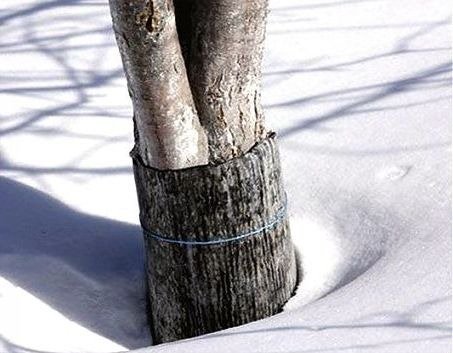

Let's take a closer look at:
- In the Middle zone (Moscow region). Trees need to be covered well, as a sudden cold snap can cause frostbite on branches and buds. To prevent this from happening, the soil must be mulched and the trunk must be wrapped with material that allows air to pass through well. For example, roofing material, stockings, etc. If frosts are expected, the apricot must be additionally covered with a film.
- In the Volga region. In this region, trees need to be shortened to a height of 2.5 m, and then insulated: mulched with a thick layer of sawdust, straw or spruce branches. Next, you need to wrap it with agrospan, which is attached to the pegs and sprinkled with earth.
- In the Urals and Siberia. Apricots need to be covered in the same way as in the Volga region, but one nuance should be taken into account. In the conditions of the northern regions, with the onset of spring, fruit-bearing trees are at risk of damping out. There is a lot of snow, which can melt during the thaw and fill the root collar with water. It will start to rot as a result of spring podoprevanie and the tree dies.
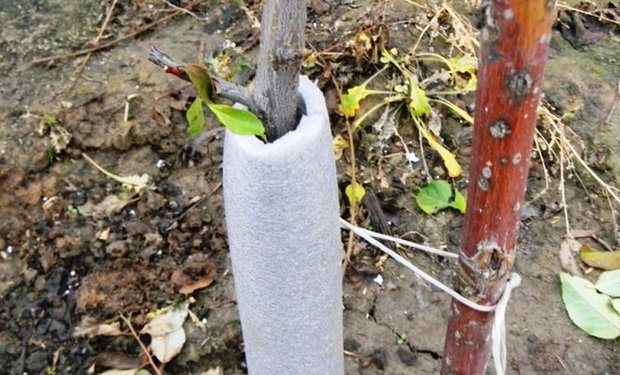

In the near-stem circle of apricot trees, snow should be trampled down in winter, especially around young plants. This will protect the trunk from mice and hares. When the threat of podoprevaniya arises (in mid-March), the snow from the root collar must be discarded.
When growing apricots in regions with severe snowy winters, frost-resistant varieties should be preferred. In such areas, trees need to be insulated.
The apricot bore fruit, the harvest was harvested, the leaves began to turn yellow. September is coming ...
How do you need to properly care for an apricot in the fall in order to prepare the tree for winter, so that it overwinters successfully and next season again delights you with even more of its delicious fruits? Let's figure it out.






